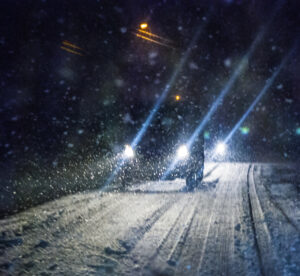New England drivers know all too well how quickly the weather can change—from sudden downpours to icy roads and blinding snowstorms. In Massachusetts, these conditions often play a role in car accidents. But while weather may contribute to a crash, it does not excuse a driver from responsibility. Understanding how liability works in these situations is critical if you or a loved one has been injured.
Weather Is a Factor, Not a Defense
Massachusetts is a comparative negligence state, which means fault is apportioned among all parties involved in an accident. Drivers sometimes assume that if bad weather caused the crash, no one is at fault. In reality, the law requires drivers to adjust their behavior to conditions on the road.
 For example:
For example:
- A driver must slow down when roads are slick with ice or snow.
- Headlights and windshield wipers must be used when visibility is poor.
- Following distances should be increased in rain, fog, or sleet.
Failing to take these precautions can result in liability for a crash and any injuries caused, even if the weather played a significant role in the accident.
Common Weather-Related Accident Scenarios
- Snow and Ice: Sliding through an intersection or rear-ending another vehicle because of icy roads often indicates the driver was traveling too fast for conditions.
- Fog and Low Visibility: Drivers who fail to use headlights or drive cautiously in heavy fog can be held responsible for accidents.
- Rain and Hydroplaning: Losing control of a vehicle on wet pavement does not eliminate fault if the driver was speeding or failed to maintain proper tires.
- Winter Storm Pileups: In multi-car accidents, investigators and insurers will assess each driver’s conduct to determine comparative negligence percentages.
How Do Massachusetts Insurance Laws Apply?
Massachusetts follows a no-fault insurance system, which means that after most car accidents, each driver’s own insurance company pays for certain expenses, regardless of who caused the crash. This coverage is called Personal Injury Protection (PIP) and can cover:
- Up to $8,000 in medical expenses and lost wages.
- A portion of replacement services, such as childcare or household help, if injuries prevent you from working or managing daily responsibilities.
However, no-fault coverage does not mean negligent drivers escape liability. If your injuries are serious—such as permanent disfigurement, broken bones, or medical bills exceeding $2,000—you can pursue a personal injury lawsuit against the driver who causes the accident. In weather-related accidents, this often comes down to proving that another driver failed to adjust their driving to road conditions.
How Can You Establish Fault When Weather Plays a Role?
Bad weather can make driving more dangerous, but it does not excuse negligent driving. Massachusetts law requires every driver to adjust their driving to the conditions around them. When an accident happens in rain, snow, or fog, proving fault often comes down to showing that a driver failed to take those reasonable precautions. Building that case involves gathering different forms of evidence, such as:
- Police Reports: Officers responding to the crash usually document road conditions, weather, and any traffic violations. These observations can help determine if a driver was speeding, failed to use headlights, or ignored other safety requirements.
- Witness Testimony: Neutral witnesses often provide critical accounts of what they saw—such as tailgating, running a light, or losing control due to excessive speed. Their statements can help establish negligence even when weather is a contributing factor.
- Accident Reconstruction Experts: In more serious cases, experts may analyze skid marks, vehicle damage, and other physical evidence to recreate the accident. Their findings can show whether a driver’s speed or maneuvers were unreasonable given the conditions.
- Onboard Vehicle Data: Many cars are equipped with event data recorders that capture speed, braking, and steering inputs. In weather-related crashes, this information (if preserved) can reveal whether a driver was traveling too fast, braked too late, or made sudden movements that worsened the loss of control.
- Video Evidence: Footage from dash cams, security cameras, or traffic cameras can provide a clear visual record of the accident. This is especially valuable in multi-vehicle collisions or pileups, where fault is often disputed.
Together, these sources of evidence show that while weather may increase risk, it does not relieve drivers of their duty to operate safely. If a driver failed to do so, they may still be held accountable for the injuries they caused.
What You Can Do Immediately After a Weather-Related Accident
Taking the right steps at the scene and shortly afterward can make a big difference in protecting your rights:
- Report the accident so police can document road and weather conditions.
- Seek medical attention if you’re injured.
- Take photographs or video of the accident scene, road surface, visibility conditions, and damage to the vehicles.
- Notify your insurance company, but avoid making statements until you consult with a lawyer.
- Contact a personal injury attorney who can investigate the accident, handle the insurance companies, and pursue the compensation you deserve.
At SUGARMAN, we have decades of experience handling complex car accident claims, including those involving weather-related conditions. If you or a loved one has been injured in a car accident and you would like to speak to an attorney, call 617-542-1000, email , or fill out our contact form.
